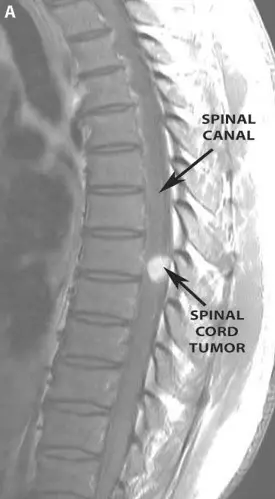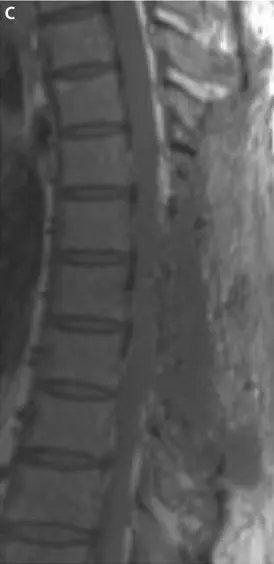Spinal tumors arise from abnormal growths of cells in and around the spinal cord. These tumors may arise from the bones of the spinal column, the coverings of the spinal cord or even the spinal cord and nerves themselves.
What Causes a Spinal Tumor?
These tumors may be primary, meaning that they originate from a group of cells in the location of tumor growth, or they may be secondary meaning that the tumor cells originate from a distant region of the body. Secondary tumors arise from metastatic cancer that has spread from another region of the body.
How Is a Spinal Tumor Diagnosed?
Patients with spinal tumor may exhibit a range of symptoms, including: back or neck pain, sensory loss and progressive muscle weakness affecting the arms and/or legs. An MRI or CT scan of the spine usually confirms the diagnosis and location of the tumor.
How Is a Spinal Tumor Treated?
The treatment options for spinal tumors depend largely upon two factors: The location of the tumor and the type of tumor. Tumor location in defined in the following ways:
- Outside of the spinal cord and its coverings (Extradural)
- Outside of the spinal cord but contained within the covering (dura) of the spinal cord (Intradural-Extramedullary)
- In the spinal cord itself (Intramedullary)
Extradural tumors are the most common type of spinal tumor and may arise primarily from the bones and cartilage of the vertebrae of the spinal column or they may represent metastatic spread from elsewhere in the body. Depending on the type of tumor treatment may include any combination of surgery, radiation and/or chemotherapy. Some tumors such as lymphoma and multiple myeloma are very radiation sensitive and commonly are treated with radiation alone. In contrast many benign tumors such as aneurismal bone cysts or osteoid osteomas may be curable with surgical resection alone. Other tumors such as metastatic lung or breast cancer are treatable with a combination of surgery and radiation and chemotherapy. Surgical treatment often involves the removal important stabilizing segments of the spine necessitating spinal reconstruction with instrumentation.
Intradural-extramedullary tumors most commonly consist of benign growths arising from either the nerve roots or the coverings of the spinal cord. Neurofibromas and schwannomas are benign growths from the nerve roots of the spinal cord. Meningiomas are benign growths that arise from the coverings of the spinal cord. These tumor types are frequently completely curable with surgery alone.
The final group consists of tumors that arise from the spinal cord itself (intramedullary tumors). Astrocytomas, ependymomas and hemangioblastomas are the most common types of intramedullay spine tumors. These tumors are usually benign and surgical excision, when possible, is the preferred method of treatment. Benign tumors that grow back following surgical resection are often treated with repeat surgery and occasionally radiation. Rarely a malignant astrocytoma or metastasis may be present. These tumors are often treated with surgery followed by radiation.
A) Pre-operative MRI with contrast of the thoracic spine demonstrating an enhancing tumor in the spinal canal compressing the spinal cord.
B) Intra-operative photograph demonstrating the tumor. Note how the tumor is distorting the spinal cord. In this case the tumor was a hemeangioblastoma.
C) Post-operative sagittal MRI of the thoracic spine demonstrating complete resection of the tumor.








